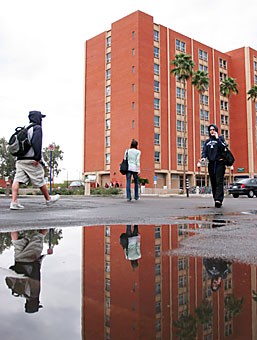Although many people on campus welcomed yesterday afternoon’s sprinkle, it was not enough to end the 78-day streak of no measurable rain in Tucson, indicative of the ongoing drought.
Art history graduate student Risha Druckman said she’s concerned this winter’s abnormally high temperatures represent larger ecological problems and said she was glad for the moisture.
“”I always welcome the rain in the desert,”” she said.
By 7 p.m. last night, the rainfall produced .04 inches on the UA campus but only trace amounts of rain at Tucson International Airport, which is where Tucson Weather Service takes measurements to determine whether the streak has ended.
Pamela Elslager, a meteorologist with Tucson Weather Service, said the last measurable rainfall was .01 inches on Dec. 12. Before that there had been no measurable rainfall since October.
The 78-day streak of no measurable rain is the 27th-longest streak on record, and Tucson is set to break the record of 114 days with no measurable rain on April 5 if current conditions continue, she said.
Elslager said the forecast predicts dry conditions for the next seven days.
“”It’s been the same pattern all winter,”” she said. “”The storm systems are north of us.””
Elslager said the most immediate danger posed by the drought is extreme fire conditions. Fire crews began being stationed in the Tucson area in February, three months before they usually arrive.
Greg Garfin, a geography and regional development assistant professor, said current conditions have been referred to as “”the perfect storm for fire.””
Garfin, program manager of climate assessment for the Southwest and co-chair of the state drought monitoring committee, said dry grasses and shrubs with more dead trees than average could mean trouble for the state.
“”It’s astoundingly dry,”” he said.
The drought has been going on for seven to 10 years depending on which expert is asked, Garfin said. Although there have been no official predictions, he said, some evidence
indicates that the drought could last another 10 or more years as a result of shifted circulation currents in the Pacific Ocean.
Below-normal precipitation is expected through May, but there should be above-average rainfall than average in the summer.
Long-term effects of the drought could change the landscape of the area, Garfin said. Some wild animals have begun moving into cities in search of water and plants such as Mesquite trees, which are adapted to the desert, are beginning to dry up.
Rivers across the state are also expected to be way below capacity this year because of the lack of rainfall. An exception is the Colorado River, which is expected to gain moisture from the states above Arizona that are receiving more moisture.
The strength of the drought has varied across areas in the state in past years, but this year La NiÇña, a strong high-pressure system over the area, has affected most of the state in the same way.
Although some rural areas in the state are being forced to haul in water, cities such as Tucson and Phoenix are in good shape because of multiple water supplies, Garfin said.
Tucson’s water comes from both the Colorado River and groundwater sources.
“”We might start seeing conservation measures taken by the city,”” he said. “”But we won’t turn into a ghost town.””
The total rainfall in Tucson for December, January and February was .01 inches, making it the driest winter season on record, Elslager said. Records of precipitation in Tucson have been kept since 1894. Normal precipitation for the winter months is about three inches.
The low rainfall from September until now has made it the driest combined fall and winter season on record, which is in contrast to last winter when there was above average precipitation, Elslager said.









